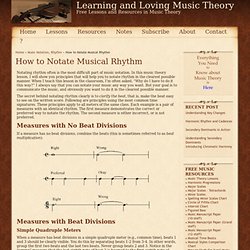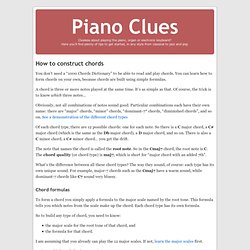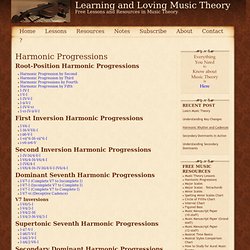Theory
> Aaronifill
> Music
List of chord progressions. MusicTheory. Ear Training Sites. Learning and Loving Music Theory. Learning and Loving Music Theory. Notating rhythm often is the most difficult part of music notation.

In this music theory lesson, I will show you principles that will help you to notate rhythm in the clearest possible manner. When I teach this lesson in the classroom, I’m often asked, “Why do I have to do it this way?” I always say that you can notate your music any way you want. But your goal is to communicate the music, and obviously you want to do it in the clearest possible manner. The secret behind notating rhythm clearly is to clarify the beat, that is, make the beat easy to see on the written score. Measures with No Beat Divisions If a measure has no beat divisions, combine the beats (this is sometimes referred to as beat multiplication): Measures with Beat Divisions Simple Quadruple Meters When a measure has beat divisions in a simple quadruple meter (e.g., common time), beats 1 and 3 should be clearly visible.
Simple Triple Meters Compound Meters Measures with Beat Subdivisions Rhythm and Meter Lesson 5. MusicalMind.org Ear Training Online. MyMusicTheory.com. How to construct chords - Piano Clues: Free tips and lessons for playing piano, organ and electronic keyboard. You don’t need a “1000 Chords Dictionary” to be able to read and play chords.

You can learn how to form chords on your own, because chords are built using simple formulas. A chord is three or more notes played at the same time. It’s as simple as that. Of course, the trick is to know which three notes… Obviously, not all combinations of notes sound good. Of each chord type, there are 12 possible chords: one for each note. The note that names the chord is called the root note. What’s the difference between all these chord types? Chord formulas To form a chord you simply apply a formula to the major scale named by the root tone. So to build any type of chord, you need to know: the major scale for the root tone of that chord, andthe formula for that chord. I am assuming that you already can play the 12 major scales. Let’s put this knowledge into practice. The formula for major chords is: 1 – 3 – 5.
One Minute Music Lesson with Leon Harrell. Learning and Loving Music Theory. Kelvin, You actually caught a mistake on the roman numerals!

Thanks, I’ll have to fix that. The first and last chords of the progression are not 7th chords. Somehow I inadvertently typed “I7″ on the first chord of all the major keys. (Notice that I didn’t do that for the minor keys.) In the classical tradition, for the sake of stability, the first and last chords of a circle-of-fifths progression are usually triads, not 7th chords. Harmonic Sequences Part 2 In the jazz tradition all chords usually are 7ths, in which case the progression will start and end with 7th chords.
Thanks again for your interest and input.
Musical Scales. Scales and emotions. See also a post about making chords from scales.

So maybe you want to write a song or an instrumental in a particular mood or style, and you’re feeling overwhelmed by all the scales. Here’s a handy guide to the commonly used scales in Western pop, rock, jazz, blues and so on. Click each image to play the scale right in your browser with the aQWERTYon. These scales have a major third (E in the key of C), which makes them feel happy or bright. Major scale Happy; can be majestic or sentimental when slow. Mixolydian mode Bluesy, rock; can also be exotic/modal. Lydian mode Ethereal, dreamy, futuristic. Lydian dominant mode Also known as the overtone scale or acoustic scale, because it is close to the first seven pitches in the natural overtone series. Phrygian dominant mode Exotic, Middle Eastern, Jewish. Harmonic major scale Majestic, mysterious. These scales have a flat third (E-flat in the key of C), which gives them a darker and more tragic feel.
Musical Scales - StumbleUpon. MusicTheory. Musicopedia - The Definitive Musicians Reference Resource. MUSICPEDIA - YOUR FAVORITE MUSIC IN PICTURES!
Musctheory.net. List of chord progressions - Wikipedia, the free encyclopedia - StumbleUpon. Harmony.org. Harmonic Functions - Anticipation - StumbleUpon. Learning and Loving Music Theory - StumbleUpon.
Music for a Higher Generation. Teoría - Music Theory Web. How To Learn Songs From Recordings.




